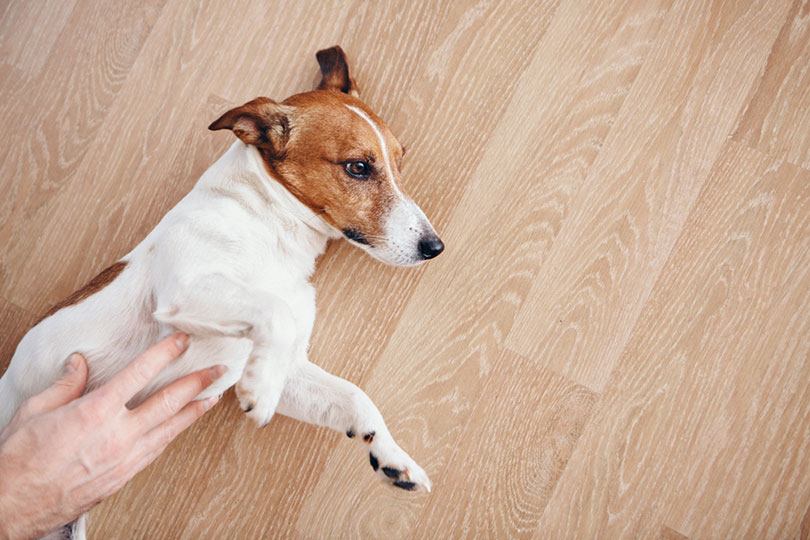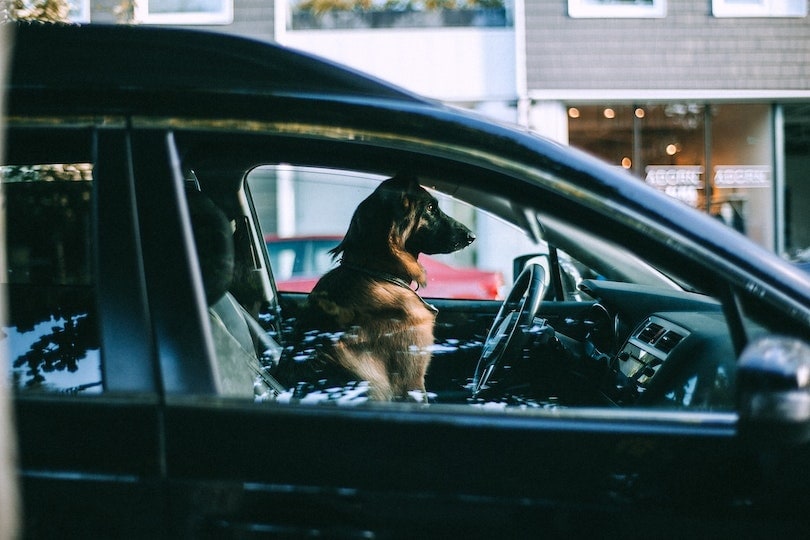German Shepherd Pomeranian Mix: Info, Pictures, Characteristics & Facts

Updated on
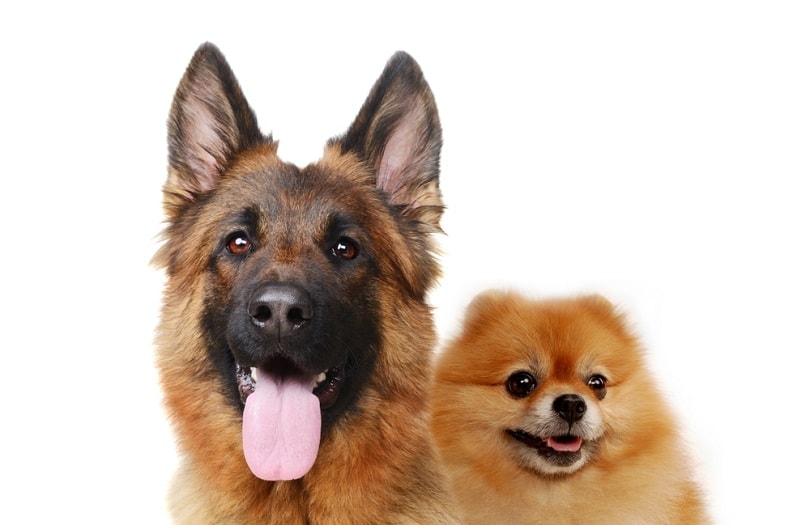
| Height: | 12-16 inches |
| Weight: | 25-50 pounds |
| Lifespan: | 10-15 years |
| Colors: | Black, tan, brown, red, fawn, brindle, blue, white, sable, cream |
| Suitable for: | Active families and individuals with plenty of time to exercise a dog |
| Temperament: | Friendly, loyal, reserved with strangers, confident, protective, alert, playful |
Many crossbreeds make sense. Take a Pitbull and Bulldog mix, for instance. Both breeds are similarly sized with builds that aren’t too far apart either. But other mixes make you think twice just imagining what the puppies would look like. The German Shepherd Pomeranian is one such cross.
German Shepherds are often as tall as 26 inches at the shoulder while Pomeranians are less than half that size, rarely standing a full 12 inches tall. The weight difference is even more drastic, with Pomeranians topping out at about 7 pounds and German Shepherds routinely weighing in at a hefty 90 pounds.
Physically, this is a strange cross. But temperamentally, things begin to make more sense. Both of these dogs are incredibly popular. In fact, the German Shepherd is the fourth most popular breed of all, according to the AKC. Pomeranians aren’t far behind, ranked as the 23rd most popular breed out of 196.
These breeds are so popular because of their easy-going, friendly personalities. They’ve got loads of bubbly energy with even temperaments and above-average intelligence for canines. And when you combine them, the German Pomeranians that result inherit the best of both worlds.
German Shepherd Pomeranian Mix Puppies
Generally speaking, crossbred dogs are less expensive than pure breeds. On top of this, German Pomeranians are a relatively new and unknown breed. You might expect all this to mean they’re more affordable, but that’s not the case because both parents command a high price.
These pups need lots of exercise and space; therefore, it is probably best you have a yard. It is also important to be able to spend time with your dog, so consider things carefully before choosing a breed.
3 Little-Known Facts About the German Shepherd Pomeranian Mix
1. The Pomeranian parent must be male.
The strangest thing about this crossbreed is the massive size difference between the parents. There can be more than an 80-pound difference in weight between German Shepherds and Pomeranians. So, how exactly do they breed?
It turns out, there’s only one way for these two drastically different sized breeds to mate. The Pomeranian must be male. A Pomeranian male can mate with a female German Shepherd, even though the logistics still seem a little off.
But this won’t work the other way around. You can’t make a German Shepherd Pomeranian mix by crossing a female Pomeranian and a male German Shepherd. The Pomeranian is likely to die from the attempt.
2. They can be difficult to housebreak.
The thing about designer breeds like the German Pomeranian is that you can never predict which parent breed they’ll take after more. You can get puppies from the same litter that take after different parents.
One of the unfortunate traits that are common to Pomeranians is that they’re very difficult to housebreak. There’s always a risk with a German Pomeranian that your puppy will inherit this trait. Of course, you’ve got a 50/50 chance, so it’s just as likely that your German Pomeranian will take after the Shepherd side more, making them much easier to train.
3. Both parents were bred to work.
Most people know that German Shepherds were bred to work. In fact, they’re some of the best working dogs ever, and they excel in a variety of fields including police work, military bomb-sniffing, and therapy. Though today they’re used for any job that we ask canines to fulfill, they were originally bred as herding dogs for sheep.
But fewer people know that the Pomeranian was also bred to be a working dog. You wouldn’t guess it from their tiny toy bodies today, but this breed used to weigh closer to 30 pounds when they were used for pulling sleds in arctic climates. Today’s Pomeranians may not bear much resemblance to their sled-pulling ancestors, but the same blood flows through their veins.
Pomeranians are part of the Spitz family of dogs, which includes canines like Huskies and Alaskan Malamutes. But Pomeranians were thrust into prominence when Queen Charlotte got two of them in the 18th century. After this, Pomeranians started being bred smaller and smaller as they transitioned from a working dog to one that’s purely meant for companionship.
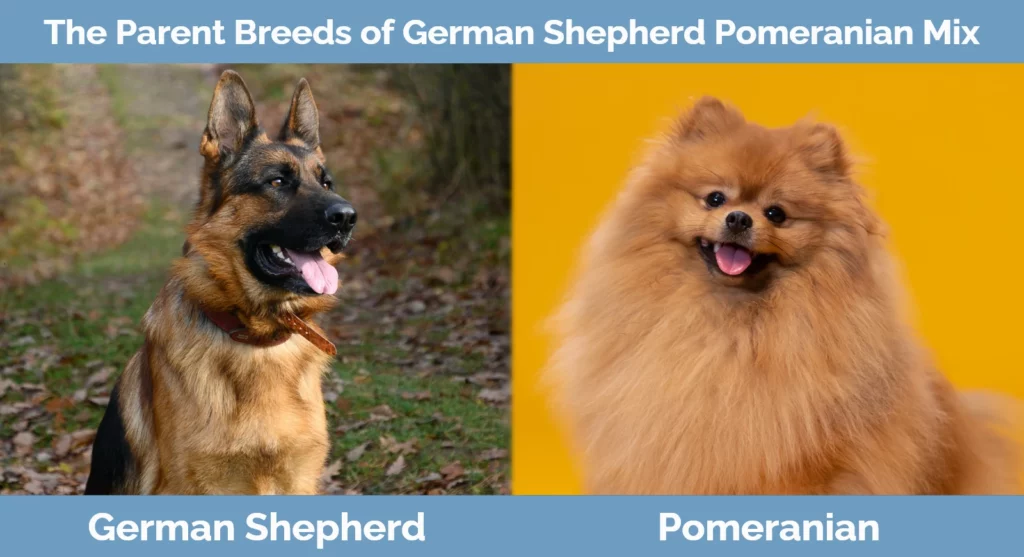
Temperament & Intelligence of the German Shepherd Pomeranian Mix 🧠
One of the main reasons that both parents of the German Pomeranian are so popular is their wonderful temperaments. German Shepherds are known as some of the most easy-going and laidback dogs of all time. They’re courageous dogs with noble attitudes that make them a pleasure to be around.
Pomeranians have become the quintessential companion pup for a reason; they’re awesome companions! These dogs are joyous, loving, loyal, and endlessly happy. They even look like they’re smiling!
Thankfully, the German Pomeranian tends to inherit the temperaments of both parents, making for a very friendly, happy, affectionate dog that’s perfect as a companion pet.
Are These Dogs Good for Families? 🏡
Because they’re so loving, fun, and affectionate, German Pomeranians are some of the best family dogs you could find. A few of these dogs might bond closely with just one person, but most German Poms are going to bond with every member of the family.
They’re also great with kids. Because they’re larger than Pomeranians, German Pomeranians tend to be a better choice for households with children. Pomeranians are so small that it’s easy for a child to accidentally hurt them, but the German Pom is much bigger and less likely to be easily injured.
Does This Breed Get Along With Other Pets? 🐶 😽
For families with pets, a dog with a strong prey drive won’t be a good fit. Luckily, neither parent of the German Pom has a strong prey drive to worry about, and these pups don’t have them either. Your German Shepherd Pomeranian mix is unlikely to chase or attack smaller dogs. Hilariously, they’re actually more likely to attack bigger dogs. German Poms are often filled with more confidence than their little bodies can hold, which often results in them acting much larger than they are. So, if you have your German Pomeranian around larger dogs, you’ll want to watch out and make sure your dog doesn’t become confrontational!
Of course, with proper socialization starting at an early age, your German Pomeranian should be able to get along great with just about everyone.
Things to Know When Owning a German Shepherd Pomeranian Mix:
Food & Diet Requirements 🦴
German Pomeranians aren’t very large, but they’re extremely active. These dogs have tons of energy that they’ll be expending every chance they get, even though their personalities are usually pretty laidback. As such, they tend to best on a high-quality dry dog food that’s formulated for active breeds so they can replenish all the nutrients they’re losing during their excessive bouts of exercise.
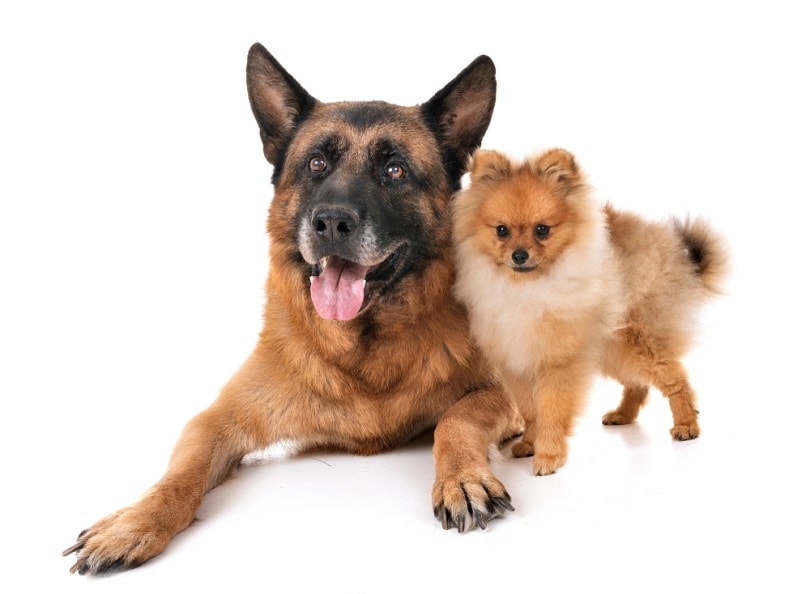
Exercise 🐕
This is where the German Shepherd Pomeranian mix becomes a bit high-maintenance. They need a lot of exercise. You’ll need a minimum of an hour each day to devote to exercising your German Pom, and some days you might need to double that. If you don’t provide enough physical stimulation for your German Pomeranian, they’re likely to become bored and destructive with too much energy pent up. Try a toy specifically for mental stimulation to help with boredom.
Training 🦮
German Pomeranians are highly intelligent dogs. They’re also people-pleasers, which makes them much easier to train. Even if you don’t have much experience training canines, a German Pomeranian is a great choice. They’re much more agreeable and easier to train than many other breeds. A lot of that is owed to the German Shepherd side of the family tree since they’re known for being easily trainable for a wide range of jobs.
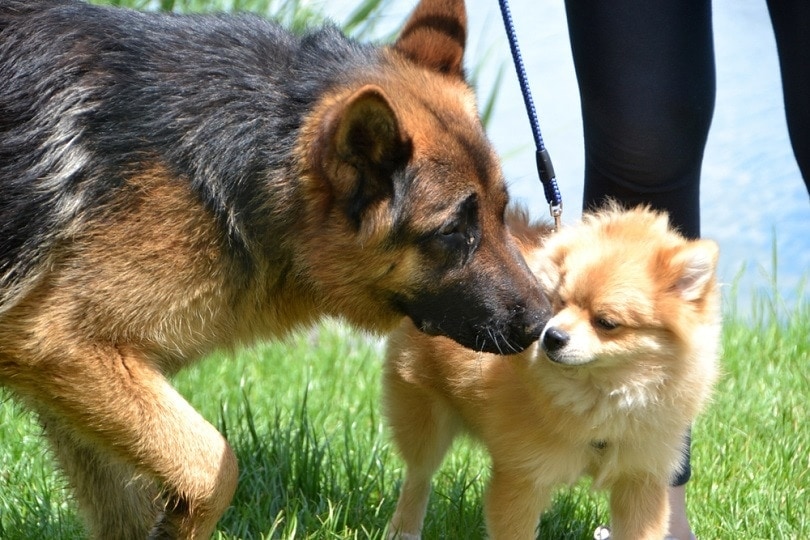
Grooming ✂️
If you know what a Pomeranian looks like, then you can guess that a German Pom is likely to need quite a bit of grooming and maintenance. But this will be dependent on which parent they take after more.
If your dog takes after the Shepherd side more, then their coat will be shorter and easier to care for. These dogs will only need to be brushed once or twice a week with occasional baths thrown in when necessary.
For German Pomeranians that take after the Pom side more, you can expect to spend twice as much time grooming at least. These pups will have tons of hair that will need brushing nearly every day. Forgo the brushing and you can expect a matted, tangled dog. And these dogs shed quite a bit as well, but if you keep up on the brushing, this shouldn’t be much of an issue.
Health and Conditions ❤️
One of the major reasons for mixing breeds is to help eliminate health concerns that are common in either breed. In the case of German Shepherds and Pomeranians, the list of health problems that are commonly associated with these breeds is extremely long. But mixing the two breeds results in puppies that aren’t susceptible to quite as many conditions. Still, there are a few health concerns common in the breed that you’ll want to keep an eye out for.
- Luxating Patella: Simply put, a luxating patella is a kneecap that can move out of place. Obviously, it’s not supposed to do that, so this is a problem. You’ll generally notice it first as a skip in your dog’s step, or they might run on three legs for a moment before using the fourth again. If you see these signs, you ought to have your German Pom checked out just to be safe.
- Hip Dysplasia: This is one of the most common health conditions that faces dogs today, particularly large breeds. German Shepherds are known to be highly vulnerable to hip dysplasia. This is a condition where the hip forms incorrectly and the top of the femur doesn’t fit properly inside of the hip socket. Because of this, they rub together, causing pain, limiting motion, and eventually resulting in lameness.
- Elbow Dysplasia: Similar to hip dysplasia, elbow dysplasia is when the elbow joint grows incorrectly, resulting in pain and limited motion. It’s one of the most common causes of lameness in dogs.
- Epilepsy: This is more common in dogs than you might think, estimated to affect nearly 1% of the canine population. It results in unprovoked seizures that can happen at any time.
Final Thoughts
The German Shepherd Pomeranian mix might seem like a strange cross at first, but once you come across one of these dogs, they’ll win you over with their friendly disposition, lovable temperaments, and laidback demeanor. But they’ve still got lots of energy that makes them fun and playful. In truth, they’re not hyper dogs at all, but they need a lot more exercise than the average person can provide. So, if you’re going to add one of these great designer dogs to your family, make sure you’ve got the time and energy to provide everything the dog needs.
Featured Image Credit: Paul Steven, Shutterstock




